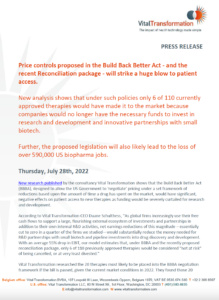Build Back Better Act
Total market impact of price controls in Medicare parts D and B
The Executive Summary
- The Build Back Better Act (BBBA) is designed to allow the US Government to ‘negotiate’ pricing under a set framework of reductions based upon the amount of time a drug has spent on the market.
- New research published by Vital Transformation (VT) shows the BBBA would essentially cut to zero the annual net earnings of a quarter of the 12 companies the firm researched as measured by EBIT (net annual earnings).
- VT developed a model that measures the impact of BBBA on the investment ecosystem and drug development of the biopharmaceutical industry and entire commercial market assuming several scenarios:
- We assume the “Maximum Fair Price”, or ceiling price, is a best-case scenario for the cohort of drugs price controlled each year.
- We estimate a further reduction of 10% below this ceiling price, based upon the evolution of pricing controls in the EU.
- We compare the projected global revenues through 2031 at average market growth rates which are far below the current rate of inflation, to the revised revenues after the implementation of BBBA.
- We use the PCE price index to measure all values in constant 2022 $USD.
- 340B prices are increasingly flowing into the commercial market and will be reset by the new ceiling price.
- BBBA states clearly that the “Maximum Fair Price”, or ceiling price, will be “announced”; there is no provision for “announced” price reductions to be confidential, inviting political pressures to apply reductions to commercial prices.
- The experience in the EU shows that prices have continued in a downward spiral once the EMA centralized procedure was put in place, we see no reason to doubt the same political pressures on pricing will be seen in the US.
- VT researched 20 therapies most likely to be placed into the BBBA negotiation framework if the bill is passed, given the current market conditions in 2022. They found those 20 therapies are produced by 12 firms and represent a substantial portion of each firm’s revenue. Fully half of all companies they researched saw a reduction of their net earnings greater than -70%, and the average reductions across the entire cohort were roughly -55%
- The 12 firms VT researched had made pipeline investments more than $588 billion over the last 10 years and 75% of that total, $439 billion, had been made in the United States. California, Massachusetts, New Jersey, and New York accounted for 80% of the US total of investments, and 60% of all pipeline investments globally
-
- Vital Transformation used a standard economic model for industry revenues as a jobs multiplier to calculate the employment impacts of the implementation of US price controls. The model estimated that annual reductions in revenues caused by BBBA would lead to roughly 600,000 lost biopharma jobs in the US and territories such as Puerto Rico in the year of 2031.
- China launched 93 early stage, venture capital backed biopharma startups in 2021.
Key Findings
- BBBA mandated price reductions impact all 12 companies, causing an average decline in net earnings (EBIT) of 55%
- The 25% most negatively impacted companies see reductions in their net earnings in excess of 100%;
- Six of the 12 companies see earnings reductions in excess of 70%.
- EBIT average reductions of 55% would substantially reduce cashflows available for R&D partnerships and pipeline investments into drug discovery and development, leaving only 6 of 110 approved therapies “not at risk” of cancelled development
- Drug prices in Europe declined 75% relative to the United States over the last 20 years. Under BBBA , VT believes the US would see similar price declines, and thus declines far exceeding the initial, pre-negotiation, BBBA price reductions (depending on “age” of a therapy) of between 25% and 60%
- BBBA does not address the increasing challenges posed by higher rebates demanded by PBMs, currently estimated to be at least 50% of companies’ gross revenues.
-
Therapies at risk of not being developed touch on the entire US population as measured by incidence rates. Potential lost therapeutics include large indications for hypertension, as well as micro orphantherapies treating Lipodystrophy.
BBBA Methodology
-
Current ASP, WAC and Non-FAMP drug prices were obtained by agreement with SSR Health.
-
BBBA revenue reductions were modeled at the drug level based upon per dose data obtained from the Medicare Part D & B Drug Spending Dashboard, audited SEC financial statements, Pitchbook, Biomedtracker by Informa, and BioCentury.
-
A historical average growth rate of CMS spending was derived from a 10-year cohort of 125 Medicare Part D and B drugs. The computed growth rate was then used to project forward current sales through the year 2034, by which time all our 2022 based drug cohort had entered the BBBA pricing model.
-
Audited sales of the top 20 drugs from Medicare Parts D and B were projected forward to simulate the impact of pricing reductions under BBBA, which is based upon the actual 2021 earnings of companies net of PBM rebates listed in their 10-K audited SEC reports
-
We opted to maintain a static 2022 drug cohort for our analysis with the understanding that many of these drugs may not meet the BBBA criteria after 2022. However, we feel the top 20 drugs included in the 2022 cohort are representative of the level of impact that will occur under the BBBA pricing framework.
-
Data on the previous 10 years of investment/partnering activity by our BBBA impacted companies were obtained from Biomedtracker and BioCentury databases. This activity was statistically reduced based on the calculated BBBA impacts on available free cashflows of each company.
-
The impact of revenue losses caused by BBBA was statistically modeled to determine the revised probability of approved products entering the market from 2012-2021.
-
The impact on employment was calculated using the 2017 IMPLAN U.S. 2017 Model by TEConomy.
Supported by





